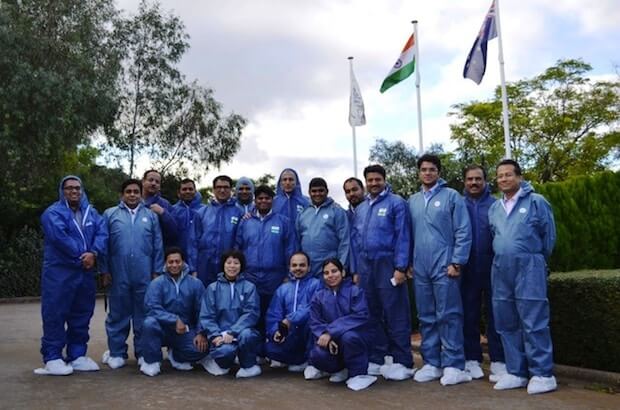New collaborations are set to open up between Indian and Australia in the dairy industry

A high-level 16 member Indian dairy business delegation visited Australia this month to explore potential collaboration opportunities.
The delegation was led by Yes Bank, India’s fourth largest private sector bank, and was supported by Austrade.
Austrade has recently signed a Memorandum of Understanding with Yes Bank’s Food and Agribusiness Strategic Advisory & Research Group (FASAR) to offer Australian experience to improve the productivity and exports of India’s food and agricultural sector, including the dairy sector, as India addresses its food security concerns.
The delegation, representing some of the largest dairy companies in India, toured Australian research institutes, farms and dairy companies to understand technologies for possible use in India.
The Indian delegation was made up of chief operating officers of agri business concerns and NGOs, agri commodities experts, research scientists, veterinary scientists and entrepreneurs in the dairy industry from across the country. They belonged to cooperative and private dairy sector companies such as the International Food Policy Research Institute (IFPRI), ITC Ltd, Gopaljee Dairy Foods, Deshpande Fopndation, Lakshya Foods, Rajkot Dairy of the Amul union
Paras Dairy, Asad Farms and Kiaro Farms.
Traveling to Melbourne and Brisbane, delegates gained an insight into Australian dairy farming, processing technology, waste management, breeding, and research and practice in genetics.
“I’m excited about the possibilities in two particular aspects,” Nitin Puri, speaking on behalf of the delegation, told Indian Link at the end of it all. “These are farming procedures and genetics. There’s a lot of scope for us to learn from Australia here, and there are significant possibilities for business collaborations as well”.
Puri is the head of FASAR, a division of Yes Bank which focuses on consulting, advisory, policy and research in food and agriculture, working in the multinational, Indian corporate, government and multilateral space.
“India is the largest producer and consumer of milk in the world at 140 million tonnes per day,” Puri said. “This means that while we are self-sufficient in dairy, we are not really exporting. Australia on the other hand, produces one-tenth of what we produce, but exports half of it, thanks to its expertise in processing and livestock development”.
Another stark difference in the Indian and the Australian industry is in farm size. “In India, there would be about two to three cows per farmer,” Puri observed. “Here, it is hundred times that number. A natural advantage is pasture areas filled with open grass. We don’t have that, sadly; and because we have to make it up with consolidated feed, cost structures become involved. The yield size, currently at 6-7 litres per farmer per day, is stagnating. We are not following good practices to see a substantial increase. In Australia, even though the number of farms have gone down in recent times, the herd size per farm has gone up, tripled in many cases, so the farms have scaled up their operations”.
Unlike Australia which is very strong on value-added longer shelf-life products such as cheese and specialised milk powders (it is the world’s fourth largest exporter of processed dairy products), the Indian consumption is in liquid milk only. But with increase in health consciousness and lifestyle in the expanding Indian middle class, this need for value-add is growing, and so the domestic market will start seeing a shortage too.
India’s National Dairy Development Board has forecast milk demand to touch 180-200 million tonnes by the end of 2020. Yet a National Dairy Plan (NDP) drawn up in 2010 proposes to nearly double India’s milk production by that time.
Fortunately, stakeholders are eager to bring in momentum to see this through.
“Unlike other areas of food production, dairy is far more evolved in India,” Puri noted. “No doubt this is because of the influences of co-operatives such as Amul in the 1960s, and more recently, the involvement of the private sector. Storage, for example, is at par with global practices, as opposed to grains which is under government control”.
Changes have also been induced by factors like easy credit facilities and dairy friendly policies by the government, so that dairy farming is less agrarian and more a professionally managed industry.
“We are currently on the lookout for initiatives to have a marketable surplus in the next five to seven years”.
And this, he is sure, will come from herd genetics.
“Genetics will be a game changer. What we’ve learnt in Australia this trip has been a revelation for us. I’m foreseeing that with Australian technology helping us in farming methods and in genetics, we will be able to increase our production substantially”.
Australia showed off its dairy expertise and technology to India at the Dairy Show in Hyderabad earlier this year. It provided an engagement model to connect with the Indian industry using the global PRETSS approach (offering expertise in policy, research, equipment, technology, services and skills).
Here’s to another white revolution in India, with a bit of help from Australia.




